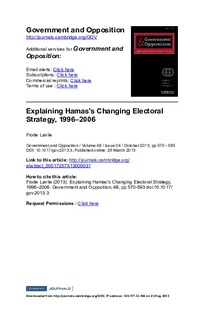| dc.contributor.author | Løvlie, Frode | |
| dc.date.accessioned | 2018-01-04T08:18:11Z | |
| dc.date.available | 2018-01-04T08:18:11Z | |
| dc.date.issued | 2013-01-01 | |
| dc.identifier | oai:www.cmi.no:4482 | |
| dc.identifier.citation | in Government and Opposition vol. 48 no. 4 pp. 570-593 | |
| dc.identifier.issn | 1477-7053 | |
| dc.identifier.uri | http://hdl.handle.net/11250/2474841 | |
| dc.description.abstract | Hamas, the most influential Islamist party in the occupied Palestinian territories, replaced its strategy of electoral boycott in 1996 with participation in 2006 – a change not explained in the literature. Assisted by party change theories, the article seeks to fill this knowledge gap. The article demonstrates that the move from boycott to participation largely can be attributed to a change of dominant coalition. In line with the theoretical assumptions, environmental challenges and shocks altered the power-balance within Hamas, robbing the coalition dominating at the time of the boycott of its power and allowing a new faction to obtain dominance. This new dominant faction saw political participation as a legitimate avenue to pursue Hamas’s cause, and its rise to power secured the change of strategy and participation in the 2006 elections. | |
| dc.language.iso | eng | |
| dc.relation | Government and Opposition | |
| dc.relation | 4 | |
| dc.relation.ispartof | Government and Opposition | |
| dc.relation.ispartofseries | Government and Opposition vol. 48 no. 4 | |
| dc.relation.uri | https://www.cmi.no/publications/4482-explaining-hamass-changing-electoral-strategy | |
| dc.subject | Hamas | |
| dc.subject | Islamism | |
| dc.subject | Democratization | |
| dc.subject | Party Change | |
| dc.subject | Elite Respondents | |
| dc.subject | Palestine | |
| dc.title | Explaining Hamas's Changing Electoral Strategy, 1996-2006 | |
| dc.type | Journal article | |
| dc.type | Peer reviewed | |
| dc.identifier.doi | 10.1017/gov.2013.3 | |
